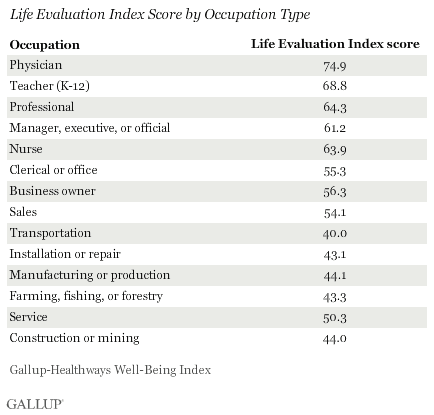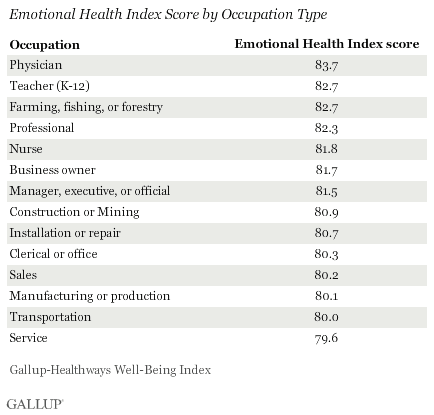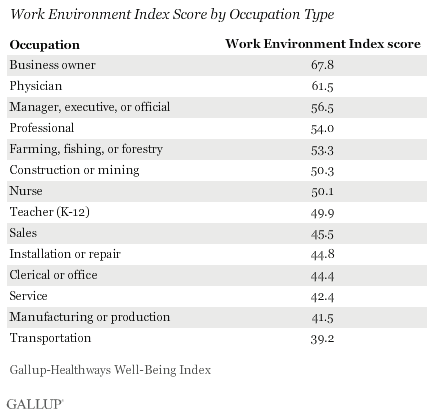WASHINGTON, D.C. -- Teachers in the United States rate their lives better than all other occupation groups, trailing only physicians. They have an average Life Evaluation Index score of 68.8, besting workers in most other types of jobs, including managers and executives, nurses, and business owners.

The research is based on interviewing conducted as part of the Gallup-Healthways Well-Being Index, which consists of six sub-indexes that measure Americans' physical, emotional, and financial health. The nation's teachers score higher than almost all occupational groups on life evaluations plus four of the other five areas of well-being -- including emotional health, healthy behaviors, basic access, and physical health. In life evaluations, emotional health, and basic access specifically, teachers come in second -- trailing only physicians, who typically earn a much higher salary. The one area in which teachers do not score as well is work environment. More generally, teachers earn the second-highest score on the overall Well-Being Index, which is based on all six sub-components, as Gallup and Healthways previously reported.
These findings are based on more than 170,000 interviews conducted from January through December 2012 with employed Americans at least 18 years of age, including 9,467 K-12 teachers.
Teachers Are in Great Emotional Health
Although workers in all professions score well on the Emotional Health Index, teachers share the second-place rank with farming, fishing, and forestry workers, trailing only physicians on this dimension. Service workers rank last.

Teachers' high level of emotional health reflects a lot of positive daily experiences, without a lot of negative ones. Teachers experience more enjoyment than those in other professions, including physicians. And they are the most likely to say they smiled or laughed a lot yesterday, at 88%. Still, teachers report high levels of stress, second only to physicians, with 47% saying they experience it daily. This is unusual, given the fact that stress typically climbs with income, and draws attention to the potential emotional health burden that teaching carries for those who pursue it. It also suggests a bigger payoff for teachers who are able to incorporate regular exercise into their schedules as a means of stress reduction.
Teachers Struggle With Their Work Environments
Despite earning top marks in most areas of well-being, teachers' answers to various questions about their workplace produces a 49.9 Work Environment Index score, which is eighth out of 14 occupation groups. The nation's educators rank sixth in saying their "supervisor treats me more like a partner than a boss." And they are dead-last --14th -- in saying their "supervisor always creates an environment that is trusting and open."
Along with another female-dominated profession -- nurses -- teachers lag far behind business owners, who hold the top spot in terms of Work Environment Index scores.

These findings are in line with Gallup's employee engagement index, which also shows that teachers are about middle-of-the-pack in terms of how they feel about their work and workplaces. About seven in 10 teachers are "not engaged" or "actively disengaged" in their work, meaning they are emotionally disconnected from their work environment. Thirty-one percent are engaged. As teacher engagement is the No. 1 predictor and driver of student engagement, these findings have serious implications for students and administrators.
Bottom Line
Teachers have high personal well-being, as evidenced by their high life evaluations and emotional well-being scores, and this may prove beneficial to their students and the broader community. It is unclear whether the relatively higher scores of teachers on several measures of well-being are because working in that profession enhances one's well-being, or if people who have higher well-being in general seek out teaching professions. Prior research, however, has demonstrated the significant role that the workplace plays in well-being outcomes.
Still, teacher's low workplace well-being, relative to other professional occupations, indicates school and community leaders have important issues to address in the school workplace in order for teachers and students to reach their full potential. It is absolutely critical to raise teachers' workplace engagement, because their engagement is the No. 1 predictor and driver of student engagement, which Gallup research shows impacts student well-being and academic success.
The positive news is that these workplace struggles can be addressed. Teachers and school leaders need to work together to improve the work environment.
About the Gallup-Healthways Well-Being Index
The Gallup-Healthways Well-Being Index tracks well-being in the U.S. and provides best-in-class solutions for a healthier world. To learn more, please visit well-beingindex.com.
Survey Methods
Results are based on telephone interviews conducted as part of the Gallup-Healthways Well-Being Index survey with a random sample of 172,286 workers, aged 18 or over, from Jan. 2-Dec. 30, 2012.
For results based on the total sample of national adults, one can say with 95% confidence that the maximum margin of sampling error is ±3.5 percentage points for the smallest group (physicians) but less than ±1 for larger groups such as professionals, service workers, or managers/executives.
Interviews are conducted with respondents on landline telephones and cellular phones, with interviews conducted in Spanish for respondents who are primarily Spanish-speaking. Each sample includes a minimum quota of 400 cellphone respondents and 600 landline respondents per 1,000 national adults, with additional minimum quotas among landline respondents by region. Landline telephone numbers are chosen at random among listed telephone numbers. Cellphone numbers are selected using random-digit-dial methods. Landline respondents are chosen at random within each household on the basis of which member had the most recent birthday.
Samples are weighted by gender, age, race, Hispanic ethnicity, education, region, adults in the household, and phone status (cell phone only/landline only/both, cell phone mostly, and having an unlisted landline number). Demographic weighting targets are based on the March 2011 Current Population Survey figures for the aged 18 and older non-institutionalized population living in U.S. telephone households. All reported margins of sampling error include the computed design effects for weighting and sample design.
In addition to sampling error, question wording and practical difficulties in conducting surveys can introduce error or bias into the findings of public opinion polls.
For more details on Gallup's polling methodology, visit https://www.gallup.com/.

